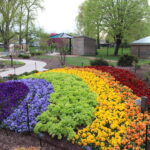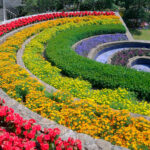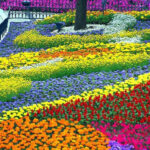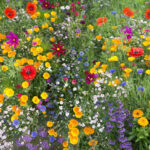Designing a garden that resembles a rainbow can be an exciting and visually striking project. Here’s a guide to help you create a vibrant, colorful garden that mimics the hues of a rainbow:
1. Planning Your Rainbow Garden
Location and Layout:
- Choose a sunny spot for your garden, as most colorful plants thrive in full sunlight.
- Decide on the shape of your garden. A circular or semi-circular design can effectively display the gradient of colors.
Soil Preparation:
- Test your soil to ensure it is suitable for a variety of plants. Amend the soil as needed with compost or other organic matter to create a nutrient-rich environment.
2. Selecting Plants by Color
To create a rainbow effect, choose plants that represent the seven colors of the rainbow: red, orange, yellow, green, blue, indigo, and violet. Here are some plant suggestions for each color:
Red:
- Roses
- Tulips
- Geraniums
- Salvia
Orange:
- Marigolds
- Daylilies
- Zinnias
- Calendulas
Yellow:
- Daffodils
- Sunflowers
- Coreopsis
- Black-eyed Susans
Green:
- Hostas
- Ferns
- Ornamental grasses
- Green herbs like basil and parsley
Blue:
- Hydrangeas
- Delphiniums
- Lobelia
- Bluebells
Indigo:
- Iris
- Clematis
- Monkshood
- Certain varieties of pansies
Violet:
- Lavender
- Petunias
- Verbena
- Alliums
3. Planting Tips
Color Grouping:
- Group plants of the same color together to create bold swathes of color.
- Transition smoothly from one color to the next to mimic the natural gradient of a rainbow.
Height Variation:
- Arrange plants according to their height, with taller plants at the back and shorter ones at the front.
- This layering technique ensures that all colors are visible and creates depth in the garden.
Bloom Time:
- Choose plants with overlapping bloom times to ensure your rainbow garden is colorful throughout the growing season.
- Incorporate perennials for year-after-year color and annuals for vibrant seasonal splashes.
4. Maintenance
Watering:
- Establish a regular watering schedule. Most colorful flowering plants need consistent moisture, especially during dry spells.
Weeding:
- Keep the garden weed-free to reduce competition for nutrients and water.
Fertilizing:
- Use a balanced fertilizer to promote healthy growth and abundant blooms.
- Follow specific feeding requirements for each type of plant.
Pest and Disease Control:
 Flower Love
Flower Love














